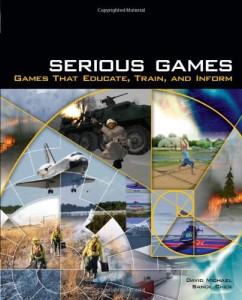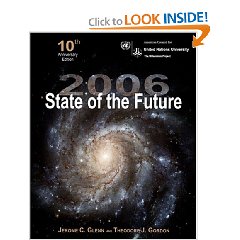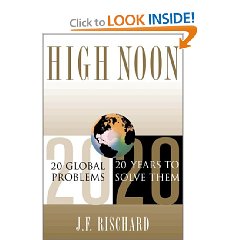
Superb Overview for both Novice Games, and Non-Gamer Sponsors of Games,
David Michael, Sande Chen
This book is exactly what I hoped for when I ordered it from Amazon. In fact, it is much more. The first part, in three chapters, talks about new opportunities for game developers, defines serious games, and talks about design and development issues.
Then the book surprises. It has entire chapters on EACH of the following: Military Games, Government Games, Educational Games, Corporate Games, Healthcare Games, and a chapter on Political, Religious, and Art Games.
Following final thoughts, the book surprises again. The appendices are world-class. Appendix A is a tremendous listing of Conferences (13 in all), and Organizations (6), Contests (1, Hidden Agenda, $25K prize–we need MORE); web sites (6, less impressive than I hoped), and publications (5). Appendix B is a survey with results, and Appendix C is a very fine bibliography as well as a very helpful Glossary of terms in the field, and an index.
Ever since I saw the US Army sponsor the Serious Games summit, and then saw the emergent success of Games for Change, I realized that we were at the beginning of a major explosion of innovation that could change the world.
In my view, Serious Games need to become the new hub for life-long education, for inter-cultural understanding, and for simulating belief systems, including evil belief systems, at both the macro and micro neuroscience levels. The Earth Intelligence Network was just created this year in order to feed free real-world public intelligence to all Serious Gamers as well as to Transpartisan policy and budget developers.
In my humble opinion, Serious Games is the next big leap in the global Internet, especially when integrated with the Way of the Wiki such that open source software standards can allow games on every threat, every policy, every budget, every location, to interact and to empower the public with tools for sense-making and consensus-building that were once limited to a small elite.
This book was everything I hoped for, and much more. I am not now and never intend to be a game developer. I want to see Serious Games expand from isolated toy-like games that focus on one small issue in isolation, to a vibrant “Co-Evolution” Sphere that in an increasingly accurate representation of the Earth, past, present, and future. This book is my ground zero in observing this field, and I have very high hopes for the future of Serious Games.










